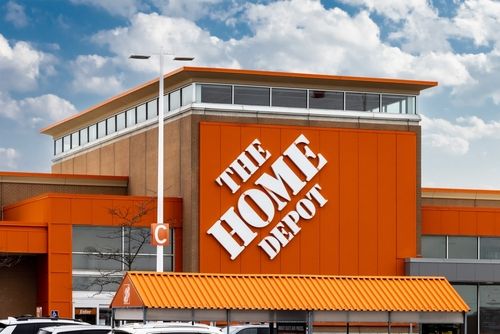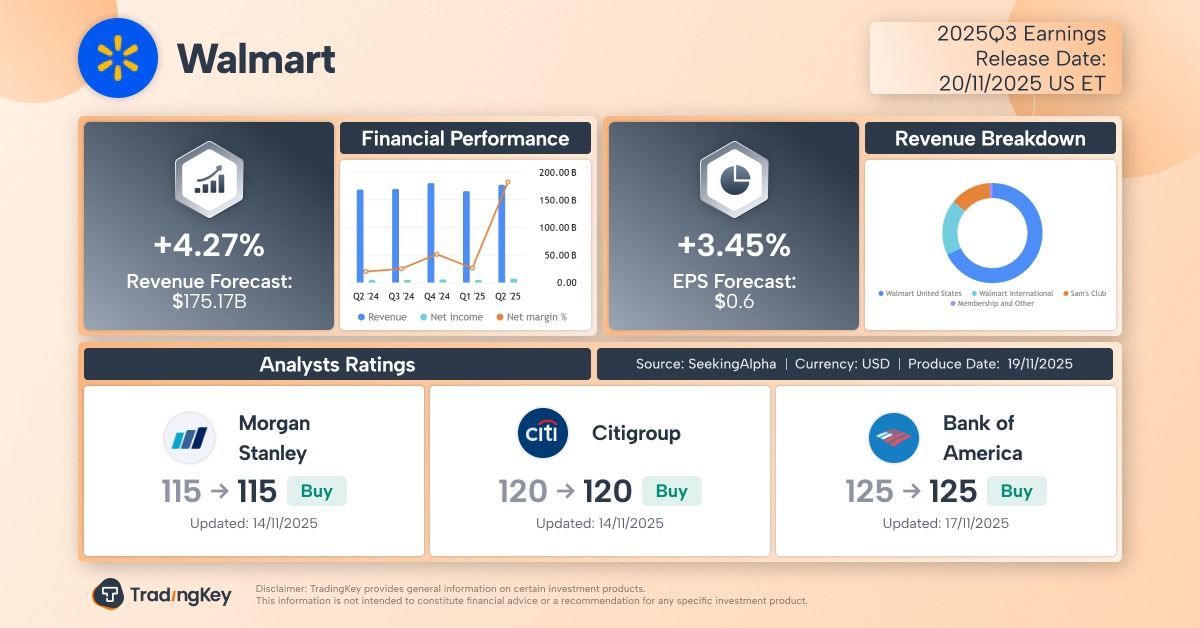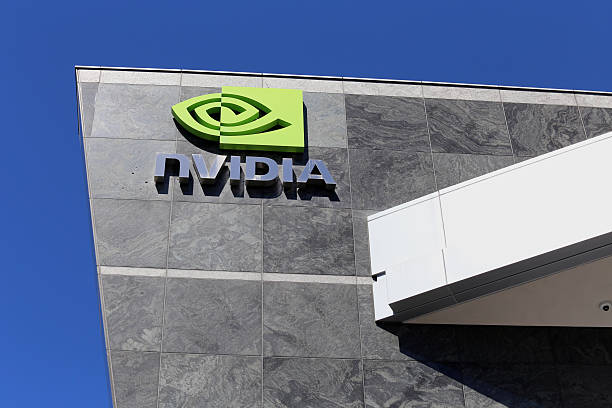Home Depot Soars 4% Against the Odds! Why Did an Earnings “Miss” Become a Stock Catalyst?


TradingKey - On August 19, 2025, Home Depot released its fiscal year 2025 second quarter earnings report, achieving sales of $45.3 billion during the reporting period, a year-over-year increase of 4.9%, with a comparable sales growth of 1.0%, including a 1.4% comparable sales growth in the U.S. market. Despite positive growth in revenue and comparable sales, the company’s GAAP diluted earnings per share (EPS) was $4.58, slightly below last year’s $4.60. However, the market reacted contrary to traditional expectations. Despite the slightly underwhelming performance, Home Depot’s stock price surged significantly after the earnings release, rising 3.95% in pre-market trading and gaining over 4% after the market opened, while the S&P 500 and Nasdaq Composite indices trended downward during the same period. Below is a detailed analysis of Home Depot’s earnings report:
Earnings Highlight
· Revenue: In the second quarter, Home Depot achieved total sales of $45.3 billion, a 4.9% increase compared to $43.17 billion in the second quarter of fiscal year 2024. Meanwhile, the company’s comparable sales grew by 1.0%, with a 1.4% increase in the U.S. market, demonstrating the continued strength of its core business.
· Earnings: The GAAP diluted EPS for the quarter was $4.58, down from $4.60 in the same period last year and below the analyst consensus expectation of $4.70.

Core Metrics Performance
Comparable Sales
In the second quarter of 2025, the company’s comparable sales grew by 1.0%, with a 1.4% increase in the U.S. market. Home Depot achieved positive comparable sales growth for the third consecutive quarter, marking a successful turnaround after eight consecutive quarters of comparable sales declines. The market views this reversal as strong evidence of the company’s strategic effectiveness and operational resilience.
Notably, the total sales growth rate (4.9%) significantly outpaced the comparable sales growth rate (1.0%), indicating that growth was primarily driven by strategic acquisitions rather than existing stores. The company opened only three new stores this quarter, with a plan for 13 new stores for the full year, contributing minimally to growth. The acquisition of SRS Distribution, consolidated into comparable sales data since June, significantly boosted sales growth. Facing uncertainties in the DIY market, Home Depot has expanded into the professional customer segment through acquisitions, building a diversified growth foundation, reducing reliance on comparable sales, and strengthening its “professional customer ecosystem” to address macroeconomic challenges.
Profitability and Margins
Home Depot’s second quarter gross profit was $15.125 billion, up 4.9%, consistent with the sales growth rate, with a stable gross margin of 33.4%, reflecting effective cost control and pricing advantages. However, operating income grew only 0.3% to $6.555 billion, and net income fell slightly by 0.2% to $4.551 billion. The “scissors gap” between revenue and gross profit growth versus sluggish operating profit and net income growth stems from significant increases in operating expenses and interest expenses. SG&A expenses rose 8.7%, far exceeding revenue growth, reflecting rising costs under inflationary pressures; interest expenses increased by 12.5% year-to-date, driven by financing costs from acquisitions like SRS. Despite management’s emphasis on operational efficiency, external costs and strategic investments continue to pressure short-term profitability.
Professional Customers vs. General Consumer Behavior
Home Depot’s second quarter performance growth was driven by customers shifting toward small-scale home improvement projects, reflecting homeowners’ “wait-and-see” mentality. In the U.S., second quarter 30-year fixed mortgage rates hovered between 6.6% and 6.7%. The high interest rate environment has created a “lock-in effect” in the housing market, where homeowners are reluctant to give up low-rate mortgages, leading to tight supply of existing homes and suppressed demand for large-scale renovations. As a result, consumers are focusing on necessary small maintenance and repair projects rather than high-cost discretionary renovations. Leveraging its brand, service, and pricing advantages, Home Depot captured demand for small projects, achieving positive comparable sales growth.
Home Depot’s professional customer (Pro) business saw a 3.2% sales increase this quarter, providing stable support for overall performance. Unlike DIY projects, professional contractors’ demand is typically ongoing and non-discretionary, as they require large quantities of roofing materials, lumber, drywall, and other construction products to fulfill contracted projects. This demand is less correlated with housing transaction volumes, making it a more stable revenue source. Strategic acquisitions (such as SRS and GMS) have expanded product lines and distribution capabilities, efficiently serving high-value customers. Compared to Lowe’s (which saw a 3.8% decline in customer traffic), Home Depot’s customer traffic decline was smaller (2.2%), reflecting its focus on professional customers and highlighting the advantages and foresight of its “Pro-first” strategy.
Future Outlook
After eight consecutive quarters of comparable sales declines, the home improvement market may have bottomed out. While current macroeconomic data (such as mortgage rates) still pose challenges, consumer spending and Home Depot’s operational performance (positive comparable sales growth for the third consecutive quarter) provide positive signals. This may indicate that Home Depot is transitioning from a cyclical retailer reliant on the DIY market to a “multichannel enterprise” that deepens its influence in the stable and high-value professional customer market through acquisitions and technological investments, thereby reducing its sensitivity to macroeconomic cycles.
Home Depot’s CEO, Ted Decker, stated that second quarter performance was “in line with our expectations” and that the company “continues to gain market share.” Despite minor “misses” in the earnings figures, management’s reaffirmation of full-year guidance signals strong confidence in the company’s strategy and future direction. This suggests that management does not believe short-term macroeconomic headwinds will derail its full-year goals and trusts that its investments in professional customers and operational efficiency will continue to deliver results.
Looking ahead to the second half of the year, Home Depot is poised to benefit from its focus on professional customers and demand for small projects. Its strategic adjustments (professional customers, technology, and efficiency) highlight its competitive advantages, shifting its valuation logic toward a more defensive and higher-growth-potential “professional services and distribution platform.”
Home Depot Q2 Earnings Bombshell: Can Pro Growth Outrun the Housing Slump?
Market Expectations
TradingKey - Home Depot's stock price has shown a moderate upward trend overall since the release of its first-quarter earnings report to date, with relatively stable stock price fluctuations, mainly influenced by macroeconomic uncertainties and weakness in the housing market, lagging slightly behind the overall performance of the S&P 500 index. Home Depot's 2025 second-quarter earnings report will be released before the U.S. stock market opens on August 19, 2025, followed by a conference call at 9:00 AM Eastern Time. Below are the expectations for its revenue and earnings per share:
· Revenue Expectation: Based on analysts' consensus, the average revenue expectation for this quarter is $45.39 billion, with a year-over-year growth rate of approximately 5.13% (last year's same period revenue was $43.17 billion).
· EPS Expectation: The average EPS expectation is $4.70, with a year-over-year growth rate of approximately 2.24% (last year's same period EPS was $4.60).
Overall, the market expects the company's performance to achieve moderate growth, but influenced by consumers' cautious spending on large home projects, the growth rate may not be as strong as in the past.

Key Investor Focus Areas
Comparable Sales: These are key indicators for measuring the company's core growth. Analysts expect overall sales growth, but if comparable sales decline (influenced by high interest rates and inflation, causing consumers to delay large home improvement projects), it may indicate weak demand, leading to short-term pressure on the stock price.
Gross Margin and Operating Expenses: Focus on whether the gross margin remains stable (gross margin slightly declined in Q1), and the control of operating expenses. If supply chain optimization or the acquisition of SRS Distribution (a professional contractor distributor) brings synergistic effects, improving gross margin, it will positively impact profitability and support the stock price; but if expenses rise (such as labor costs or energy prices), it may compress profits, leading to EPS falling short of expectations and triggering selling pressure.
Professional Customers & Consumer Customer Demand: The company is strengthening its professional contractor business through the acquisition of SRS. If the earnings report shows strong growth in the professional customer segment, this will buffer the impact of weak consumer spending, provide long-term growth momentum, and may drive the stock price higher in the medium to long term; conversely, if the housing market is sluggish (high mortgage rates suppressing renovation demand) leading to weak overall demand, the stock price may face downside risks.
Inventory Management and Supply Chain Risks: Focus on inventory levels and the impact of tariffs/trade policies. If inventory is well optimized and supply chain diversification is successful, it will reduce cost risks and positively impact performance.
Full-Year Guidance Update and Macro Outlook: The company has reiterated its 2025 fiscal year guidance of 2.8% sales growth, 1% comparable sales growth, and approximately 2% decline in EPS. If the Q2 earnings report lowers the guidance, it may trigger market concerns, leading to significant stock price fluctuations; if maintained or raised, it will enhance investor confidence and support a stock price rebound.








